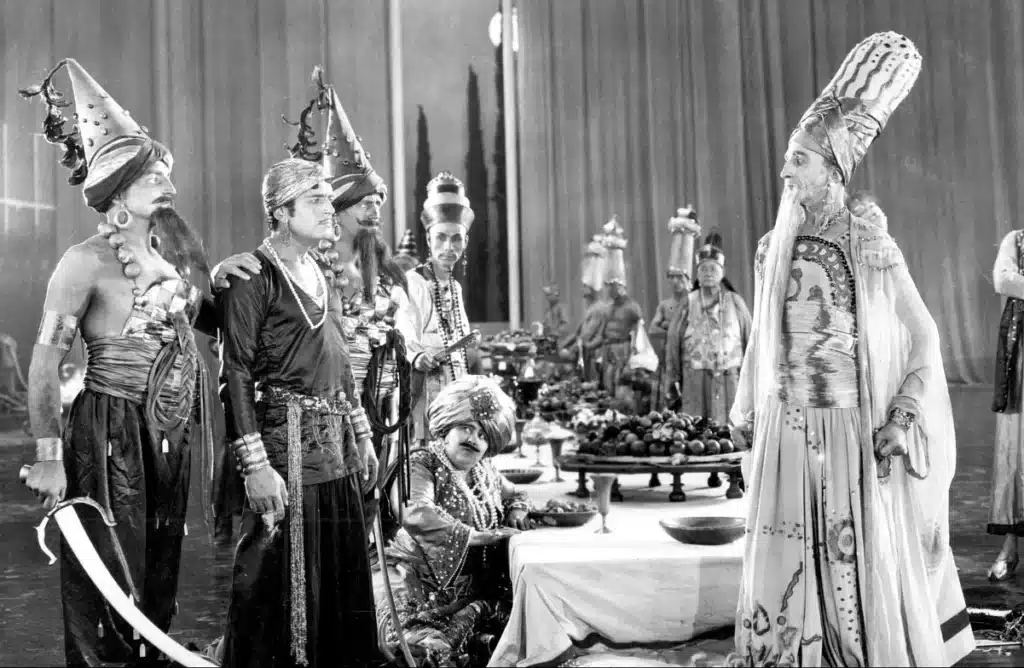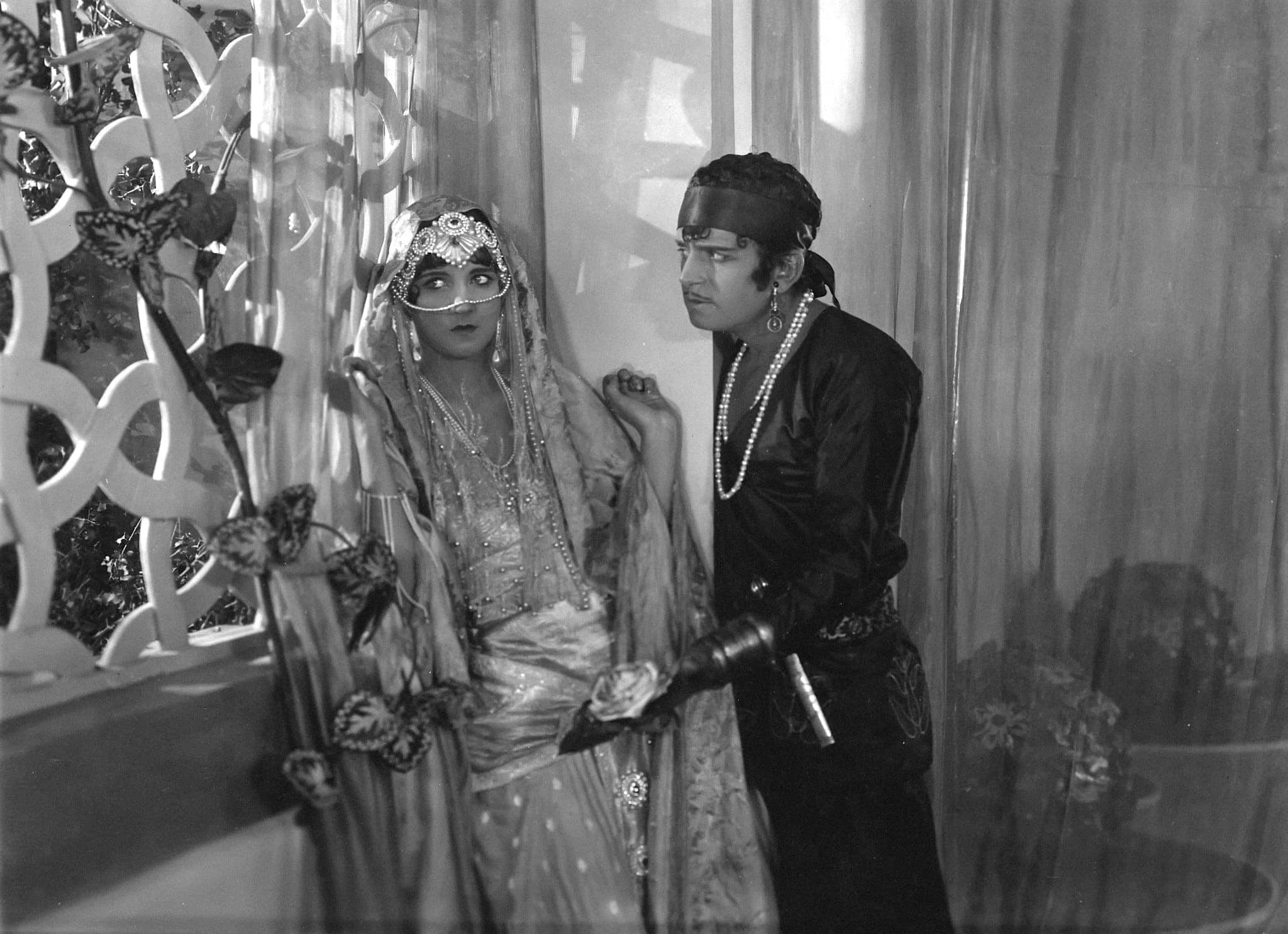Douglas Fairbanks was the Tom Cruise of a century ago and in 1924’s The Thief of Bagdad, Fairbanks’s favourite of his own films, you get to see him at his very best, in the peak of physical condition, in a film that’s one remarkable action set piece after another.
As you’ve probably guessed, it’s silent, in black and white and set out in old Bagdad, where an Arabian Nights story unfolds concerning Ahmed (Fairbanks), a common street thief caught up in the machinations over who will wed the country’s fair princess (Julanne Johnston). Many would scale those walls, not least Ahmed, though he understands he has only a snowball’s chance in hell against the princess’s urgent official suitors: a prince from India (Noble Johnson); another from Persia (Mathilde Cormont); and not even a snowball’s chance against the wily prince of the Mongols (Sôjin Kamiyama).
But Ahmed has something the high-born princes do not have – street smarts and a body that looks like its owner has alternated mornings at the gym with afternoons at the spray salon. He’s as buff as a tractor, and since Fairbanks does almost the entire film shirtless, he clearly wants us to know that he’s put the hours in.
The film breaks down into two distinct halves. In the first we meet Ahmed the Thief, introduced via a series of remarkable stunts that involve Fairbanks scaling walls, doing handstands, bouncing into and out of gigantic earthware jars, climbing down the rope in an Indian rope trick and so on, before accidentally meeting the princess (he’s trying to rob her) and falling for her, and her for him.
Which sets us up for part two, which is one of those fairytale quests in which the princess’s suitors are dispatched to the four corners of the known world and charged with bringing back the most valuable treasure they can find. Whomsoever brings back the most valuable item shall have the hand etc etc etc.
Part one relies largely on the physicality of Fairbanks and his stunts are brilliantly conceived and executed and also done with a “how’s about that!” flourish. Light as air, lovely stuff – you really won’t see better. Part two is a cavalcade of special effects as the three princes (and Ahmed) tour foreign parts to find the exotic treasure that will win one of them the princess. A wingèd horse. Prehistoric beasts. Enchanted trees coming to life. A giant bat (ludicrous). A segment beneath the waves (brilliant). And to top it all a flying carpet (a piece of sheet steel running on cables, but look at it go).
The second half would undoubtedly have wowed audiences a century ago, with its procession of novel effects. Some of them still work very well – the undersea stuff will have you leaning forward to see how it’s done and the carpet is genuinely brilliant. But the effect is slightly plodding on account of the one-thing-after-another quest structure. The first half holds up better these days, largely on account of it being mostly physical effects and old-fashioned stuntwork – the Tom Cruise stuff – and it has a plot.

If you’ve seen Fairbanks’s Robin Hood film from two years before, it’s noticeable that he’s lost weight and buffed up a lot for what’s obviously a physically much more highly demanding role. He’s slightly loosened up his acting style as well. He’s still arms akimbo, legs athwart, head thrown back in laughter and all that, but there’s often a wink to the camera this time. Fairbanks knows he’s hamming it up and wants the audience to know he knows.
Helping him here is Snitz Edwards, who plays thief Ahmed’s wingman. He does a lot of go-between work with the audience, rolling his eyes and gesturing and making sure we are keeping up. Quite why he’s billed as the Thief’s “Evil Associate” (on Wikipedia and the IMDb, the film itself no longer appears to have credits) is a complete mystery – there’s nothing evil about him at all, quite the opposite.
That’s Chinese America’s first star, Anna May Wong, as the princess’s duplicitous handmaiden, every inch the 1920s flapper as well as the plausible Mongol slave girl secretly feeding intel to the Mongol prince. William Cameron Menzies’s sets do something similar, summoning up the old Bagdad of minarets and Islamic windows while also leaning into the Art Deco style of the era. They’re particularly suitable for the boxy film format – tall rather than wide – and it’s noticeable how often Menzies (the term “production designer” was coined for him) sends his creations upwards, ever upwards, towers, spears, even the endless fronds of seaweed as Ahmed swims to the bottom of the ocean.
The original score was by Mortimer Wilson and it can be found on the innumerable versions of this film you can find on YouTube. Since The Thief of Bagdad is out of copyright and in the public domain there is no shortage of copies online, of varying quality – see the one on Wikipedia, the entire film is there, if you want an example. A good restoration was done in 2012 by the Cohen Film Collection and it’s the one to go for (the Eureka edition, which used to be available in the UK but no longer seems to be, uses the Cohen restoration too). It has a new score by Carl Davis, which borrows heavily from Rimsky-Korsakov’s Scheherezade. It’s not his best work and doesn’t always suit the action, but you can’t have it all.
It doesn’t detract too much from the spectacle, which is really what this film is all about, and Fairbanks’s genuinely thrilling performance. This is often rated as his best film, as one of the greatest entertainments of the silent era and as one of the best action movies ever made. It’s hard to argue with any of that.
The Thief of Bagdad (Cohen Film Collection version) – Watch it/buy it at Amazon
I am an Amazon affiliate
© Steve Morrissey 2024

